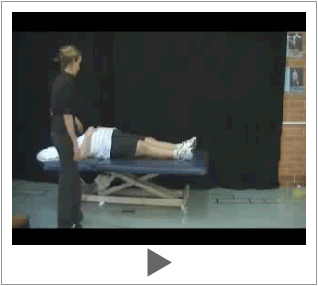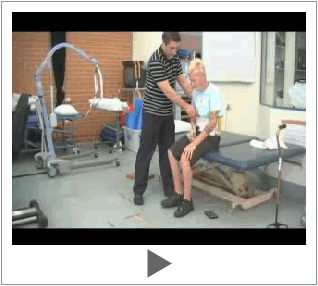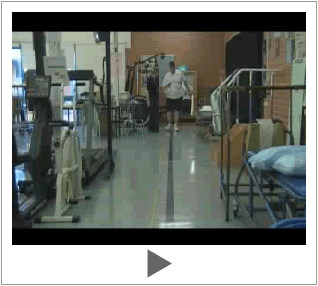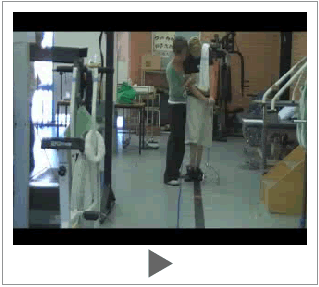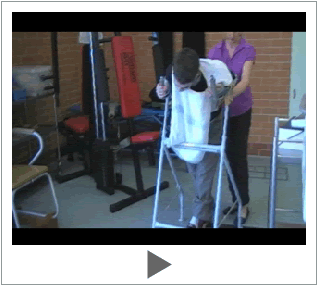- SELF STUDY MODULES
- 1. Intro to TBI
- 2. Communication
- 3. Skills for independence
- 4. Cognitive changes
- 5. Behaviour changes
- 6. Sexuality
- 7. Case management (BIR)
- 8. No longer available
- 9. Mobility & motor control
- 10. Mental health & TBI:
an introduction - 11. Mental health problems
and TBI: diagnosis
& management - 12. Working with Families
after Traumatic Injury:
An Introduction - 13. Goal setting
- 9.0 Aims
- 9.0A Take the PRE-Test
- 9.1 Brain injury and motor symptoms
- 9.2 Common physical presentations
- 9.3 Role of physiotherapy
- 9.4 Physiotherapy interventions
- 9.4a Motor retraining
- 9.4b Prevention of secondary complications
- 9.4c Fitness training
- 9.4d Regular physical activity
- 9.5 How can carers help make physiotherapy happen
- 9.6 Minimising risks
- 9.7 Take home messages
- 9.8 Resources
- 9.9 Take the POST-test
9.4a Motor retraining
i) Introduction
Training to improve a task needs to involve practicing components of that specific task as well as the whole task. This is essential to training as postural adjustments required to maintain balance while performing a task are specific to that task. Each individual will have a specific programme designed to meet their needs and prescription of exercises will be based around the missing or altered essential components of the task. Following are some examples of motor retraining for some commonly seen motor impairments:
ii) Moving in bed
Some individuals have difficulty moving around in bed, as well as getting in and out of bed. Specific exercises can be given by a qualified physiotherapist to assist the individual in becoming more independent in this task. Some general strategies to assist someone getting to the edge of the bed include:
- Bending the knees and prompting or assisting the individual to roll onto their side.
- Once in sidelying, provide prompts or assistance in getting the individual to push through their arms into a sitting position. Simultaneously, the legs should be brought over the edge of the bed.
- Ensure the individual is safe sitting on the edge of the bed, by providing supervision or hands on assistance to ensure their safety.
Strategies to ensure safety include:
- Providing simple and clear instructions.
- Being aware of safe manual handling techniques and good back posture when providing manual assistance.
- Seeking additional assistance when necessary
Video 4: (above) Demonstration from moving from lying down to sitting on the edge of the bed.
Click on the image to go to the video player. The video may take a few moments to load.
iii) Sit to Stand
Weakness down one side of the body (hemiparesis) may result in reduced weight bearing through the affected leg, reduced knee extension and leaning to the weaker side. Exercises may be prescribed by the physiotherapist to increase the loading of the weaker leg so that there is more even weight bearing when standing. This can make the indiviual more stable and reduce the risk of falls.
Strategies to ensure safety during practice include:
- Standing on the affected side to assist with support.
- Using manual handling tools such as a walking/transfer belt to ensure a secure hold of the client.
- Having additional assistants if unsure of client’s ability.
- Establishing the number of repetitions of the exercises that will be performed during each session.
- Using a chair at an appropriate height for the individual to safely practice. If a chair is too low, it will be more difficult for the individual to stand up from.
Video 5 (above) Demonstration of assisting someone to stand from a bed.
Click on the image to go to the video player. The video may take a few moments to load.
iv) Walking
A client who presents with a hemiparesis may require ongoing walking retraining to improve the quality of their movements. Improved quality of walking can result in reduced energy exenditure for the client, improved strength and thus an ability to walk for longer periods.
When walking with a client with hemiparesis, the following strategies should be considered to assist in safely practicing the task:
- Using manual handling tools such as a walking/transfer belt to ensure a secure hold of the client.
- Using appropriate walking aids as prescribed by the treating physiotherapist
- Standing on the affected side to assist with support.
- Having additional assistants if unsure of client’s ability.
- Ensuring the area in which you are walking is free of clutter and potential trip hazards.
- Establishing the distance in which you are going to walk and ensuring there is somewhere to sit down if need be.
Video 6 (a) (Above) Providing minimal physical assistance to an individual when walking
Click on the image to go to the video player. The video may take a few moments to load.
Video 6 (b). (Above) Providing moderate assistance to an individual walking with a quad stick.
Click on the image to go to the video player. The video may take a few moments to load.
Similarly, a client who presents with an ataxic gait may benefit from walking practice to increase distance and endurance as well as the quality of their movement. The above strategies would be useful in ensuring walking practice can occur in a safe environment for both the client and the carer. It should be noted however, that an ataxic gait is less predictable and as such requires extra vigilance when supervising walking practice.
Video 6 (c). (Above) Walking with a forearm support frame with an individual who has ataxia.
Click on the image to go to the video player. The video may take a few moments to load.
As well as practicing whole motor tasks (e.g. sit to stand and walking), the physiotherapist may also prescribe more specific exercises to target components of the motor task that need improvement. For example, the physiotherapist may prescribe some lower limb strengthening exercises for a person with a hemiparesis who is unable to sufficiently take weight through their affected leg. These exercises may be presented in an exercise book which the carer can use with the client to facilitate practice and monitor progress. (Example: Attachment 2)
The treating physiotherapist will also recommend the use of walking aids as necessary. This may include items such as a walking frame, a walking stick or orthoses. Prescription of such items is a clinical decision based upon ensuring the safety of the client as well as enabling independence. If a carer has concerns regarding the use of any aids, it is important that these are raised with the treating physiotherapist. The carer may also be required to ensure that the device is maintained in good condition and that no secondary complications arise from its use. This may involve monitoring of the skin integrity to ensure there is no breakdown as a result of wearing an orthoses.
